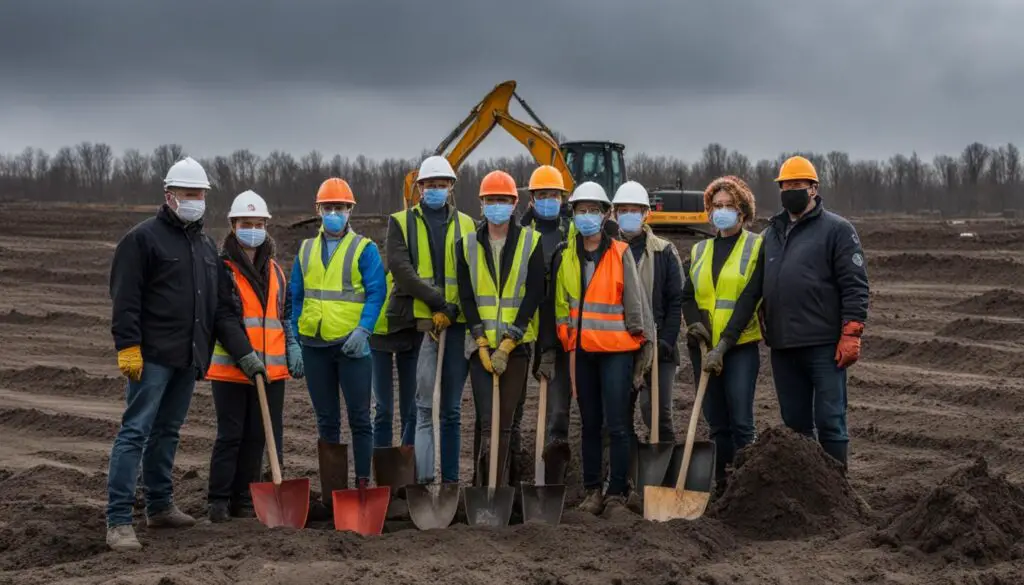Trees are not just a beautiful part of our natural landscape; they play a vital role in our environment and provide numerous benefits that support life on Earth. From improving air quality to mitigating climate change, trees offer a wide range of ecosystem services that are essential for the well-being of both nature and humanity.
Key Takeaways:
- Trees provide a multitude of benefits and services that support life on Earth.
- They improve air quality, help mitigate climate change, and sequester carbon dioxide.
- Trees are vital for maintaining biodiversity and supporting wildlife habitats.
- They contribute to the overall well-being of communities and enhance the aesthetics of urban areas.
- Trees have practical and commercial value, providing renewable resources and various products.
Community & Social Value
Trees hold immense value for our communities, creating a sense of tranquility and enhancing the aesthetics of our surroundings. Whether they line our streets, grace our parks, or stand as historic landmarks, trees play a crucial role in enriching our quality of life. They provide shade and create a serene atmosphere, inviting us to enjoy outdoor activities and connect with nature. Trees also contribute to the pride and identity of our neighborhoods, symbolizing our shared values and heritage.
Urban trees are essential in transforming concrete jungles into green oases, offering respite from the hustle and bustle of city life. They provide shade on hot summer days, reducing the urban heat island effect and maintaining pleasant temperatures in their vicinity. Parks with abundant trees become havens for relaxation and recreation, fostering a sense of community and social engagement. These green spaces serve as gathering points for neighborhood events, picnics, and leisurely strolls, promoting social interaction and strengthening ties among residents.
Trees have a significant impact on the value of our urban landscape. Well-planned tree-lined streets not only enhance the visual allure of our cities but also increase property values. Studies have shown that properties with tree-lined streets command higher prices and are more desirable among prospective homeowners. The presence of trees, with their natural beauty and calming effect, creates a welcoming atmosphere, transforming mere streets into inviting and inviting corridors.
Trees also hold historical significance and cultural value. Historic trees can be witnessed in various parts of our cities, serving as reminders of the past and landmarks of our shared history. These ancient trees connect us to our roots and provide a sense of continuity and collective memory.
Table: Benefits of Trees in Our Community
| Enhancement of Quality of Life | Contribution to Community Pride and Identity | Aesthetic Appeal and Visual Delight |
|---|---|---|
| – Creation of a peaceful and serene environment | – Symbolizing shared values and heritage | – Beautification of streets and neighborhoods |
| – Provision of shade for outdoor activities | – Serving as gathering points for community events | – Transformation of concrete jungles into green oases |
| – Urban heat island mitigation | – Strengthening social ties among residents | – Increasing property values and desirability |
Ecological & Environmental Value
Trees play a crucial role in maintaining the ecological balance and preserving the environment they inhabit. Their immense value extends to multiple aspects, including oxygen production, carbon sequestration, air quality improvement, water conservation, soil preservation, and wildlife habitat.
Oxygen production by trees: Through the remarkable process of photosynthesis, trees absorb carbon dioxide and release oxygen into the atmosphere, playing a vital role in oxygen production. This natural mechanism helps alleviate the effects of climate change and ensures a breathable environment for all living beings.
Carbon sequestration by trees: Trees act as nature’s carbon sinks, absorbing and storing carbon dioxide from the atmosphere. This process, known as carbon sequestration, helps mitigate the harmful effects of greenhouse gas emissions, reducing global warming and climate change.
Air quality improvement by trees: Trees act as natural air filters, capturing and removing pollutants such as fine particulate matter and harmful gases from the air. By improving air quality, trees contribute to the health and well-being of both humans and wildlife, reducing respiratory issues and creating a cleaner environment.
Water conservation by trees: Trees provide essential water conservation services by regulating water flow and preventing soil erosion. Their extensive root systems absorb and store rainwater, reducing surface runoff and helping to recharge groundwater aquifers. This function is vital for maintaining healthy water cycles and ensuring the availability of clean water resources.
Soil preservation by trees: The roots of trees hold the soil in place, minimizing erosion caused by wind and water. This crucial function protects the topsoil, preventing degradation and loss of nutrients. Trees also contribute to the formation of organic matter in the soil, supporting its fertility and overall health.
Wildlife habitat: Trees provide essential habitats for a diverse range of species, serving as homes and sources of food for wildlife. Forests and woodlands rich in various tree species support an abundance of flora and fauna, contributing to overall biodiversity. The preservation of tree habitats is crucial for the survival and well-being of countless species.
| Ecological & Environmental Benefits of Trees | Examples |
|---|---|
| Oxygen production | Sustains life and enables respiration for humans and animals |
| Carbon sequestration | Helps reduce greenhouse gas emissions and mitigate climate change |
| Air quality improvement | Filters pollutants and improves air freshness and cleanliness |
| Water conservation | Regulates water flow, reduces soil erosion, and preserves water resources |
| Soil preservation | Prevents soil erosion, enhances fertility, and maintains nutrient-rich soil |
| Wildlife habitat | Provides homes and food sources for a diverse range of species |

Personal & Spiritual Value
Trees hold a deep personal and spiritual significance for many people. Their beauty and majesty symbolize strength, endurance, and resilience. When we spend time among trees, we often experience a profound sense of peace, comfort, and connection to the natural world.
Emotional Connection with Trees: Trees have a unique ability to evoke powerful emotions within us. Whether it’s the sight of a majestic oak tree standing tall or the gentle rustling of leaves in the wind, trees have a way of touching our hearts and stirring our souls. They provide a sense of grounding and stability, reminding us of the beauty and wonder of life.
Tree Memorials: Many individuals plant trees as a way to honor the memory of loved ones or commemorate significant life events. These living memorials serve as a lasting tribute, representing the enduring connection between nature and the cherished memories we hold dear.
Childhood Memories of Trees: For many of us, trees hold cherished memories from our childhood. They were our playgrounds, our secret hideouts, and the silent witnesses to countless adventures. The trees we climbed, the leaves we collected, and the shade they provided on hot summer days are etched in our hearts forever.
“The best time to plant a tree was 20 years ago. The second best time is now.” – Chinese Proverb
Our personal and spiritual connection with trees reminds us of the importance of preserving and caring for these remarkable beings. They enrich our lives in ways that words cannot fully express, and their value reaches far beyond their physical presence.
| Country | Notable Tree Memorial |
|---|---|
| USA | The 9/11 Survivor Tree in New York City’s Memorial Plaza |
| Japan | The Atomic Bomb Survivor Trees in Hiroshima |
| Canada | The Anne Frank Tree in Vancouver |
| Kenya | The Wangari Maathai Memorial Trees in Nairobi |
Practical & Commercial Value
Trees are not only essential for the environment and our well-being, but they also offer practical and commercial value that enriches our daily lives. Let’s explore some of the ways in which trees contribute to various aspects of our society.
Timber Production
One of the primary commercial uses of trees is timber production. Trees provide high-quality lumber for construction purposes, offering a sustainable and renewable source of building materials. From residential homes to commercial buildings, timber from trees plays a crucial role in shaping our built environment.
Wood-Based Products
Trees serve as a vital source of raw materials for numerous wood-based products. The versatility of wood allows it to be transformed into furniture, flooring, paper, and various other goods. By utilizing tree resources, we create durable and functional products for our homes and businesses.
Fruit Production
Trees provide a bountiful harvest of fruits and nuts, contributing to our agricultural industry and food supply. From apple orchards to vast citrus groves, fruit production from trees offers a diverse range of flavors and nutrition to satisfy our taste buds.
Medicinal Use of Trees
The medicinal properties of trees have been known and utilized for centuries. Many tree species contain compounds that have therapeutic effects on our health. From traditional medicine practices to modern pharmaceutical research, trees offer a natural source of healing and well-being.
Did you know? The bark of certain tree species, such as the cork oak tree, is used to produce cork, which has various uses in the industry. Tree extracts are also utilized in the production of chemicals and medicines, contributing to the advancement of science and healthcare.
An Engaging Table Demonstrating the Variety of Commercial Uses of Trees
| Commercial Use | Description |
|---|---|
| Timber Production | Provides sustainable building materials for construction purposes. |
| Wood-Based Products | Transformed into furniture, flooring, paper, and other goods. |
| Fruit Production | Contributes to the agricultural industry and food supply. |
| Medicinal Use | Contains compounds with therapeutic effects on health. |
As seen in the table above, trees offer a multitude of commercial applications that benefit various sectors of our economy, enhancing our daily lives and contributing to the prosperity of industries.

Property Value & Economic Value
Trees have a significant impact on property value and the economy. When it comes to real estate, trees are more than just beautiful additions to the landscape – they can actually increase the value of a property.
Homes with well-maintained landscapes, including trees, command higher selling prices. Studies have shown that properties with mature trees can have a value increase of up to 20%. Buyers are often willing to pay a premium for homes with established trees, recognizing the aesthetic appeal and environmental benefits they provide.
Not only do trees enhance the visual appeal of a property, but they also provide practical benefits that can lead to energy savings. The shade provided by trees can significantly reduce cooling costs during the summer months. Trees strategically placed around a house can act as natural windbreaks, reducing heating costs in the winter. This energy-saving effect can lead to lower utility bills and increased energy efficiency.
In addition to the direct energy savings, trees also have an indirect impact on property value through their landscaping benefits. Well-designed landscapes with trees can greatly enhance the attractiveness and marketability of homes. Tree-lined streets, lush green yards, and carefully curated gardens all contribute to the overall appeal of a property.
Real estate appraisers recognize the positive impact of trees on property values. They take into account the presence and condition of trees when assessing a property’s worth. Trees are considered valuable assets that enhance the desirability and curb appeal of a property, ultimately increasing its economic value.
Overall, trees contribute to economic prosperity and financial benefits for homeowners. Whether through increased property value, energy savings, or enhanced curb appeal, investing in trees is a smart decision with long-term financial rewards.
Climate Change Mitigation
Trees play a crucial role in mitigating climate change. As the world grapples with increasing greenhouse gas emissions and rising temperatures, trees offer a natural solution to combat these challenges. Through their innate ability to absorb carbon dioxide, trees contribute to carbon sequestration and help reduce the harmful effects of global warming.
Carbon sequestration is the process by which trees absorb carbon dioxide from the atmosphere through photosynthesis, converting it into oxygen and storing the carbon in their biomass. This process not only reduces the levels of greenhouse gases in the atmosphere but also helps offset human activities that contribute to climate change.
Tree planting initiatives have gained significant recognition as an effective strategy for climate change mitigation. By planting more trees, we can enhance carbon sequestration, creating greener and healthier environments. Tree-based solutions provide cost-effective and sustainable methods to tackle the adverse impacts of climate change.

Health Benefits
Trees have profound effects on human health. Spending time in nature, such as among trees in parks, has been shown to reduce anxiety and depression. Access to green spaces encourages physical activity, leading to improved physical health and reduced rates of obesity. Trees also play a role in air pollution reduction, filtering out harmful particulate matter and improving air quality in urban areas. The presence of trees contributes to healthier and happier communities.
Studies have demonstrated the positive impact of trees on mental health. The serene and tranquil environment provided by trees in nature has a calming effect, reducing stress and anxiety. Spending time amongst trees can improve mood and overall psychological well-being. Nature-based interventions, such as forest bathing and nature walks, are employed as therapeutic techniques to promote mental health and alleviate symptoms of various mental health conditions.
Additionally, trees have tangible benefits for physical health. Access to green spaces encourages outdoor activities and exercise, which are vital for maintaining a healthy lifestyle. The availability of shaded areas provided by trees allows for outdoor exercise even during hot weather, reducing the risk of heat-related illnesses. Furthermore, trees promote respiratory health by reducing air pollution. Their leaves act as natural filters, trapping and removing pollutants such as particulate matter and ozone, which can cause respiratory problems and exacerbate existing conditions such as asthma.
Research has shown that the presence of trees in urban areas can mitigate the negative effects of air pollution on human health. A study conducted in urban neighborhoods found that higher tree cover was associated with lower rates of emergency room visits for respiratory problems.
Moreover, trees contribute to the overall well-being of communities by providing a sense of place and improving the aesthetic appeal of neighborhoods. The sight of trees and greenery has been linked to increased life satisfaction and reduced psychological distress. The peaceful ambiance of tree-lined streets, parks, and gardens creates a restorative environment, allowing individuals to escape the stresses of daily life. The positive influence of trees on health extends beyond physical and mental well-being, fostering social connections and promoting a sense of belonging and community cohesion.
The health benefits of trees are inextricably linked to their role in reducing air pollution. Trees are known for their ability to absorb carbon dioxide and release oxygen through photosynthesis. In addition, they act as filters, trapping pollutants such as nitrogen dioxide, ozone, and particulate matter. This not only improves air quality but also reduces the risk of respiratory diseases and other health problems caused by pollution. The presence of trees in urban areas can significantly contribute to the reduction of air pollution levels, benefiting the health of residents and enhancing the overall quality of life.
The numerous health benefits of trees underscore the importance of preserving and increasing urban green spaces. By recognizing and harnessing the potential of trees, we can create healthier and more sustainable communities for generations to come.
Water Management
Trees play a vital role in water management. They contribute to water conservation, water filtration, and the reduction of stormwater runoff, all of which are crucial for the sustainable management of water resources.
One of the key ways trees help in water management is through water conservation. The root systems of trees absorb and store rainwater, reducing runoff and preventing flooding. This process helps to replenish groundwater levels and maintain a balanced water cycle.
Trees are also excellent water filters. As rainwater passes through the canopies and branches of trees, it is naturally purified. Trees remove pollutants and sediments from the rainwater, improving its quality and protecting the underlying soil and groundwater from contamination.
Stormwater runoff reduction is another critical benefit provided by trees. The extensive root systems of trees act as natural barriers, absorbing and slowing down the flow of stormwater. This helps to reduce the volume and velocity of runoff, preventing soil erosion and minimizing the risk of flash floods.

The image above illustrates the process of water filtration by trees, showcasing how they naturally remove contaminants and improve water quality.
By conserving water, filtering pollutants, and reducing stormwater runoff, trees have a significant impact on the overall management of water resources. They contribute to the sustainable development of communities and help create a more resilient and eco-friendly environment.
Conclusion
In conclusion, trees play an indispensable role in our planet and society, providing a wide range of benefits and services. They improve air and water quality, support wildlife habitats, and mitigate climate change by sequestering carbon dioxide. Trees also have a positive impact on our well-being, both physically and mentally, fostering healthier and happier communities.
Moreover, trees contribute to property value and economic prosperity, enhancing the overall livability of our neighborhoods. Their practical and commercial uses, such as timber production and medicinal properties, make them invaluable resources. It is vital that we recognize and conserve the vital roles that trees play in our lives.
By taking action to protect and plant trees, we ensure a sustainable future for generations to come. Let us appreciate and harness the numerous benefits of trees, from their environmental and ecological services to their personal and economic value. Together, we can create a world where trees thrive, benefiting both nature and humanity.
FAQ
What do trees do?
Trees play a crucial role in our ecosystem, providing numerous benefits and services that support life on Earth.
What are the benefits of trees?
The benefits of trees are vast and include improving air quality, supporting biodiversity, mitigating climate change through carbon sequestration, and providing renewable resources.
What is the importance of trees?
Trees are essential for the well-being of both nature and humanity. They enhance our quality of life, contribute to the environment and ecosystems, and hold personal and spiritual significance for many individuals.
What is the environmental role of trees?
Trees improve air quality, regulate water, and provide habitats for wildlife. They also absorb carbon dioxide and release oxygen through photosynthesis, helping to mitigate climate change.
What are the ecosystem services of trees?
Trees provide essential ecosystem services, including carbon sequestration, oxygen production, air and water quality improvement, and soil preservation.
How do trees help mitigate climate change?
Trees sequester carbon dioxide from the atmosphere through photosynthesis, helping to reduce greenhouse gas emissions and offset human activities that contribute to global warming.
How do trees contribute to renewable resources?
Trees provide timber for construction, fuel for heating and cooking, and raw materials for numerous products. They also bear fruits and nuts for human consumption and serve as a source of medicine.
What is the role of trees in mitigating climate change?
Tree planting initiatives are recognized as important climate change mitigation strategies, offering cost-effective and sustainable solutions to combat the adverse effects of climate change.
How can tree conservation help?
Conserving trees is crucial to maintain their vital roles in our lives and ensure a sustainable future. It helps protect biodiversity, preserve ecosystems, and maintain the numerous benefits trees provide.

